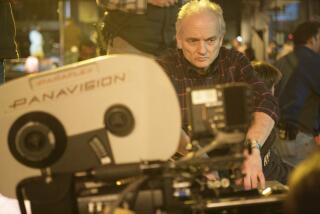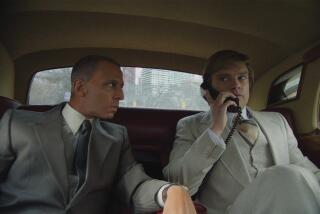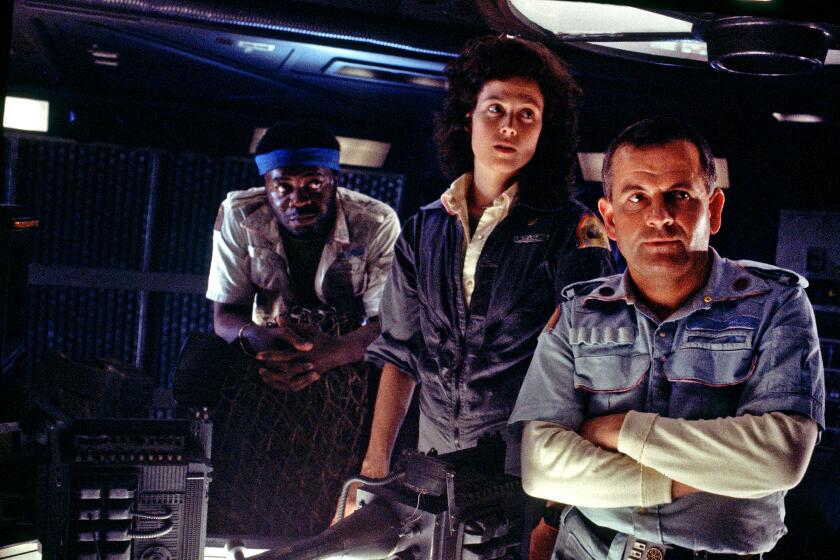Perspective: Is David Cronenberg our most original director?
Hypnotic or stupefying? “This is the third time I’ve seen it, and I still don’t know if it works,” a colleague told me as we left a screening of David Cronenberg’s”Cosmopolis.” I totally understand. The movie is undeniably something — but what exactly?
Adapted from Don DeLillo’s stormily received 2003 novel about a 28-year-old currency speculator, the billionaire master of an imploding financial universe whose whimsical desire for a haircut entails an entire day crossing gridlocked midtown Manhattan via stretch limo, “Cosmopolis” is an exercise in constant natter and glacial forward glide — a movie that lulls even as it disconcerts.
Critical consensus at Cannes skewed negative: The Times’ Kenneth Turan called “Cosmopolis” (opening in Los Angeles on Friday) a “static,” “mishandled” adaptation of DeLillo’s novel, further noting that “incredibly,” the strongest performance was delivered by Robert Pattinson, the vampire heartthrob of the”Twilight” films, here cast as Wall Street bloodsucker Eric Packer.
“Cosmopolis” isn’t the first Cronenberg movie to flop at Cannes. However consistent in his themes and ideas, he seems to work against expectation.
The 69-year-old Toronto-born and -based director’s first movies depicted futuristic dystopias, and most of his subsequent productions, not least “A Dangerous Method,”the faux-genteel period piece released last year, have an alienated, science-fiction flavor. “Cosmopolis,” which gives the not unintentional impression of doggedly pushing the viewer 15 minutes into the future a few seconds at a time, makes the sci-fi element overt. Sound-proofed and screen-filled, Packer’s limousine space capsule has intimations of the moon shuttle in Stanley Kubrick’s “2001,” even as the director’s visual strategies recall those from two other radical ‘60s films, the discontinuous zoom of Michael Snow’s “Wavelength” and the lengthy traffic jam tracking shot inJean-Luc Godard’s “Weekend.”
Indeed, Cronenberg is not only Kubrick’s heir as the most experimental narrative filmmaker at work today but the most provocative and consistently original North American director of his generation.
Granted, Martin Scorsese’s quartet of “Mean Streets,” “Taxi Driver,” “Raging Bull” and “The King of Comedy,” all with Robert De Niro, is an accomplishment without parallel in post-’60s Hollywood cinema, and, yes, Steven Spielberg is a pop-culture virtuoso as well as the most influential commercial moviemaker of the last 35 years. But despite his gifts, Scorsese has never returned to his early form while, for all his ambition, Spielberg’s supreme achievements remain his pure entertainment machines (“Jaws,” “E.T.,” “Jurassic Park”). Two other contenders, David Lynch and Brian De Palma, have each made brilliant films (“Blue Velvet,” “Blow Out”), but more often than not their experiments have blown up in the lab; scanning the horizon, the tallest tree is Paul Thomas Anderson.
Cronenberg’s career-long consistency is unmatched. Of the dozen movies he directed in the course of the near-three-decade run that began with “Videodrome” in 1983, the only clinkers have been “Dead Zone” and “M. Butterfly.” That both were Hollywood productions suggests that, like media theorist Marshall McLuhan and the comic geniuses who developed “SCTV,”Cronenberg benefited from a particular aspect of the Canadian condition — attuned to American popular culture but necessarily distanced from, and never entirely immersed in, it. Unlike a Jim Jarmusch or Todd Haynes, Cronenberg is not opposed to the mainstream but simply outside it.
Along with those American peers who came to cinema in the wake of the French New Wave, Cronenberg began by making cheap, subversively avant-garde genre films and, as demonstrated by two recent commissioned films, “A History of Violence,” a hyper-real version of an early ‘50s B-movie nightmare, and its companion piece, “Eastern Promises,” an exotic gangster-family drama, he remains a consummate genre director — for whom genre serves as a sort of Trojan horse.
Coolly understated, save for its sudden bursts of mayhem, Cinema Cronenberg has the knack for evoking one thing while speaking to another. Made during the ‘70s, his outré cheapsters “They Came From Within” and “Rabid” became retrospectively prophetic during the AIDS crisis of the ‘80s. His media satire “Videodrome,” in which a baleful TV signal causes James Woods to develop a VCR-like cavity in his abdomen, was followed by a luridly operatic remake of the ‘50s monster movie “The Fly,” and “Dead Ringers,” an unnervingly gender-specific Hitchcockian thriller that cast Jeremy Irons in the role of twin gynecologists; and when, in 1991, Cronenberg unexpectedly adapted William Burroughs’ phantasmagoric “Naked Lunch,” it was clear that all of his previous, borderline exploitation films were savage, visionary burlesques in the Burroughs tradition.
Spielberg had already turned to serious literary material in making “The Color Purple” and, with “The Age of Innocence,” Scorsese soon would as well; Cronenberg’s adaptations were distinguished by the challenge they presented in adapting them to cinema. Not a film version of the Burroughs novel, Cronenberg’s “Naked Lunch” was a fantasy of how the book came to exist; rather than tackleJ.G. Ballard’s childhood memoir (the source of Spielberg’s”Empire of the Sun”), Cronenberg chose to adapt the novelist’s scabrous, all but non-narrative “Crash” — a riff on the notion of “auto-eroticism” which, dropped by its distributor and banned in the U.K., would be the most controversial Canadian movie of all time.
The central Cronenbergian precept, derived from McLuhan or, perhaps his own experience as a filmmaker, is that, increasingly modified by or merged with technology, humans are essentially cyborgs. This is most comically illustrated by the biomorphic TV sets of “Videodrome” and organic “game ports” of its video game update “eXistenZ” and most poignantly dramatized by “Crash,” which imagines our species as vulnerable bits of protoplasm seeking some sort of comfort in the crevices of a lacerating, metallic world.
In some respects, “Cosmopolis” is “Crash” without high-impact car wrecks. Packer’s limo functions as a bedroom, if not a source of sexual excitement, and, by modifying several scenes, the filmmaker has made DeLillo’s novel even more auto-centric. The movie is also more alienated — not only in Cronenberg’s digital cinematography, featuring synthesized backgrounds as disconcerting as Hitchcock’s rear-screen projection, but in his fidelity to his source material. Panning DeLillo’s novel, Walter Kirn wrote that the dialogue “reads like an unholy collaboration between Harold Pinter and Robby the Robot.” That’s exactly how it plays. The movie’s characters don’t speak their lines so much as they are spoken by them — the protagonist is a zombie Mark Zuckerberg trapped inside the game world Cronenberg invented in “eXistenZ.”
Over the years, Cronenberg has variously positioned himself as Freudian and anti-Freudian. In any case, he shares a common view that to be human is to definitely not be the master of one’s own house. Packer’s limo may be an elaborately controlled environment in which, as an ultimate demonstration of his power, he brings the world to him — not just on computer screens but in person, joined on his journey by a succession of doctors and analysts. At the same time, the outsized car that rolls mindlessly through the clogged streets is the “death drive” made material. It’s even possible that “Cosmopolis” has a happy ending in that Packer finally realizes this.
More to Read
Only good movies
Get the Indie Focus newsletter, Mark Olsen's weekly guide to the world of cinema.
You may occasionally receive promotional content from the Los Angeles Times.








